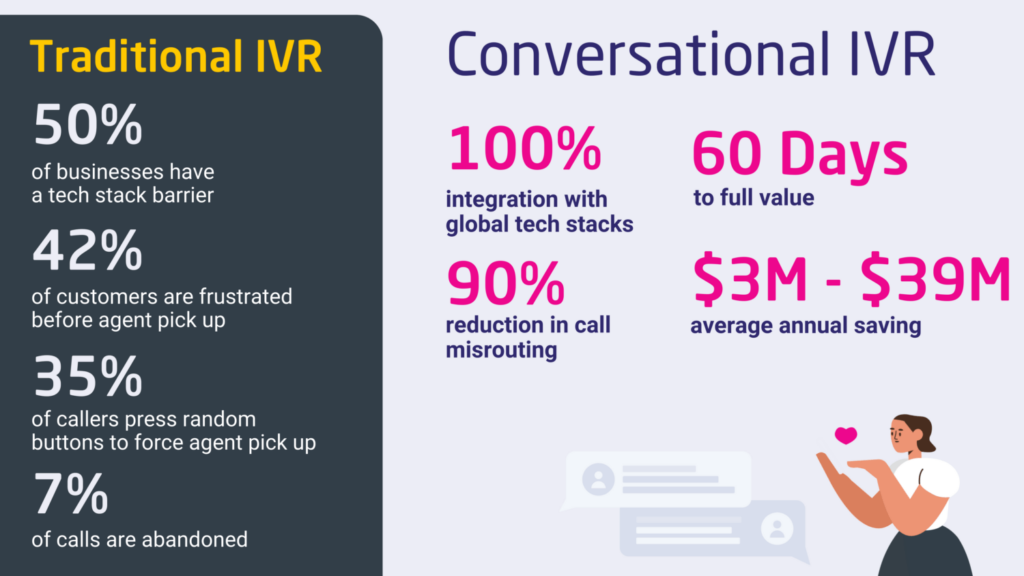What is Conversational IVR?
IVR stands for Interactive Voice Response, an automated phone system that interacts with callers. It uses voice prompts and touch-tone inputs often with keypad navigation. The goal of IVR technology is to route calls to the appropriate recipient. Furthermore, IVRs also gather information from the caller, or provide information to the caller.
The technology works by playing a series of pre-recorded voice prompts that guide the caller through the call. For example, a system might ask the caller to enter their account number or to select an option from a menu. The caller inputs their response by pressing the touch-tone buttons on their phone. Then, the system uses that information to determine the next step in the call.
Businesses program IVR systems to handle a wide range of tasks. For example, they can route calls to specific departments, taking payment information, and providing information on products or services. Businesses use this technology to handle large volumes of calls more efficiently. It allows them to handle many calls at once without the need for live agents.
What is the difference between is Conversational IVR and Traditional IVR?
Conversational IVR (Interactive Voice Response) is a system that interacts with customers through natural language conversations over the phone. It provides a more welcoming experience. In contrast to traditional systems, Conversational IVR relies on pre-recorded voice prompts and menu options.
In conversational IVR, customers can communicate naturally. Then, the system uses artificial intelligence (AI) to understand the customer’s intent and respond with relevant information. This helps answer customers questions quickly and efficiently without having to navigate through multiple menu options.

What is a Modern IVR?
A modern IVR is a cutting-edge technology that serves as a key component of call center automation. It enables businesses to streamline customer interactions and manage high call volumes. Likewise, it provides efficient customer service, all while reducing operational costs.
Contact center automation refers to the implementation of advanced technologies and software that automate tasks and processes. In short, the objective is to ultimately improving customer experience and agent productivity.
Explore the deeper intricacies of Interactive Voice Response technology and its transformation over the years.
Companies can design Modern IVR systems to be user-friendly and intelligent. They use natural language processing and artificial intelligence (AI) to accurately understand and process customer queries. By integrating these cutting-edge technologies, modern IVR systems are capable of automating a range of tasks, such as call routing.
Learn more about the implementation of modern IVR systems in our recently published e-book.
Traditional IVR
Businesses often design Traditional IVR systems without prioritizing the user experience. Hence, they can be frustrating to use and can lead to negative experiences for customers. This is a result of the fact that companies often design IVR systems to automate tasks and reduce costs. Instead, they should be focusing on creating a positive user experience. Customer experience is essential to any business’s success, and contact centers play a critical role in delivering exceptional service. However, traditional Interactive Voice Response or IVR systems face challenges like poor customer satisfaction and higher labor costs.
Discover the common pain points users often face with older IVR systems.
There are several reasons why IVR systems may not always provide a great user experience. Customers often find traditional IVR systems to be complicated and frustrating. As a result, contact centers see increased misrouted calls, wait times, pressure on customer service agents and poor customer satisfaction. Moreover, businesses are losing billions of dollars every year due to poor customer experience, according to CustomerThink.
What are the pros and cons of IVR in a Contact Center?
High Transfer Rates
Many customers still want or need to speak to a human agent. IVR’s primary function is to route callers quickly. The objective is to get the user to the most appropriate human agent available. However, misrouting is a very common issue.
Poor call routing leads to customers being transferred multiple times and having to repeat their issue each time. This can be frustrating for both the customer and the agent, who is tasked with resolving the issue. High transfer rates waste valuable agent time and increase customer wait times.
Limited Self-Service Options
IVR systems are designed to handle a limited set of tasks, such as routing calls or providing basic information. However, if a customer has a more complex issue that requires human interaction, IVR can create frustration. In some cases, it can also lead to longer wait times and high abandonment rates. A high abandonment rate is problematic for organizations as it means customers are dropping out of the customer service system. Equally important, low abandonment rates and excellent customer service are crucial for customer loyalty.
Complex Navigation
Callers tend to zero out or hang up quickly if IVR menus are too complex. This can lead to frustration and confusion, especially for users who are not familiar with the system. Call containment measures the percentage of customers who complete their enquiry using self-serve technologies. A poor call containment rate means the IVR system isn’t fulfilling its function of providing self-serve automation for high-volume enquiries.
Limited feedback and interaction: IVR systems can also feel impersonal, with limited feedback and interaction options. Customers feel like they are talking to a machine rather than a human, which can lead to frustration and dissatisfaction.
IVR technology can provide cost savings for companies by automating tasks and reducing the need for human agents. It can result in a reduction of FTEs and other operational costs. However, an IVR will negatively impact the customer’s experience.
Conversational IVR technology can enhance the cost savings potential by providing a more efficient and personalized customer experience.
Conversational IVR systems can be integrated with existing customer service systems. They can be used to automate routine tasks such as providing account balances or flight information. As a result, it can free up customer service agents to handle more complex issues.
Overall, conversational IVR can provide customers with a more welcoming customer service experience. At the same time, it can help businesses reduce costs and improve customer satisfaction.
Conversational IVR in a call center is a technology that allows customers to interact with a company through voice.

What are the Benefits of Conversational IVR?
According to ContactBabel some of the benefits of conversational IVR systems are:
Reduced call volume:
Conversational IVR can handle simple queries and free up agents to focus on more complex issues. As a result, this can reduce call volumes. Conversational IVR systems can reduce costs by automating routine interactions and reduce staffing costs.
Improved customer satisfaction
Providing a more human experience, leads to higher customer satisfaction. Conversational IVR is a more natural and intuitive interface for customers, allowing them to interact with a company using voice. By providing faster and more accurate responses, reduce misrouting and wait times as customers do not need to repeat themselves.
Increased call efficiency
Handle multiple requests at once and often resolve issues without transferring the call to a live agent. Conversational AI can help your business save time and improve efficiency.
Cost savings
By automating routine tasks, businesses can direct calls to the right department, and provide information on products and services. With less misrouting contact centers can reduce the need for human agents.

Increased accessibility
Businesses can integrate Conversational IVR with other technologies, such chatbots, to create a multi-channel customer service experience.
Check out this short video from Swisscom to understand what Conversational IVR made a difference for their call center.
Impact of AI-powered IVR
The impact on businesses and customers can be significant. Businesses can improve their customer service processes and reduce costs. At the same time, customers can get the information they need more quickly and efficiently. Additionally, conversational IVR can help businesses gather valuable customer insights and make data-driven decisions to better meet customer needs.
Learn how AI plays a pivotal role in modern call routing systems, enhancing the IVR experience.
How to Calculate The ROI of IVR Solutions
Research from ContactBabel cites that the cost of a live service telephone call varies considerably. A call has a mean average of £5.42. In contrast, the average historical cost of a telephony self-service session is estimated to be around 30-70p.
There are a number of studies showing that IVR harms the Telephone Experience. For example, a 2019 survey by Avaya found that 60% of customers felt frustrated with IVR systems. Similarly, 68% said that they had hung up the phone because of a frustrating experience with an IVR system.
The main problem with keypad navigation in IVR systems is that the experience is predetermined. Customers are forced to navigate a pre-determined path, and call center reps are limited in how they can assist customers. This can lead to frustration and poor customer experiences.
Swisscom, for example, has a customer enquiry hotline that uses a voice-controlled system to improve the customer experience. The system assigns customer enquiries quickly and accurately, maximizing the valuable resources of the hotline agents.
Read how one of Europe’s largest telecommunication providers achieved IVR success, here.

Discover Conversational IVR Benefits for Your Business
In today’s fast-paced business world, it’s more important than ever to provide customers with quick and efficient customer service. One way to achieve this is by using conversational IVR. This innovative technology uses AI and natural language to simulate a human conversation. In short, it makes it easier for customers to get the help they need.
Here’s why your business should consider using conversational IVR, based on research from ContactBabel and Teneo.ai.
Increased Customer Satisfaction
Increase customer satisfaction is one of the biggest benefits of using conversational IVR. According to ContactBabel, customers are more satisfied with their telephone experience by speaking to an IVR system instead of navigating a menu. This is because conversational IVR provides a more intuitive and seamless experience.
Improved Call Efficiency
Improved call efficiency is another benefit of Conversational IVR. Research from Teneo.ai has shown that conversational IVR can reduce average handle time (AHT). Furthermore, it can improve average speed to answer (ASA). This is because a solution with open questions can handle multiple requests at once. It also can often resolve issues without transferring the call to a live agent. This save businesses time and money, while also providing customers with a more efficient experience.
More Accurate Data Collection
Conversational IVR can also collect more accurate data on customer interactions. Businesses can use this data to improve the system and make better business decisions. For example, businesses can use this data to identify areas where they can improve their customer service processes. It allows managers to make changes to better meet customer needs.
Increased Accessibility
Conversational IVR integrates with other technologies, such as chatbots, to create a seamless, multi-channel customer service experience. This makes it easier for customers to get the help they need, regardless of their preferred method of communication. This increased accessibility can lead to higher customer satisfaction and improved call efficiency.
In conclusion
Conversational IVR is a cutting-edge technology that offers numerous benefits for businesses, including increased customer satisfaction and improved call efficiency. Based on research from ContactBabel and Teneo.ai, it’s clear that conversational IVR is a valuable investment for any business. Especially those looking to provide top-notch customer service.

